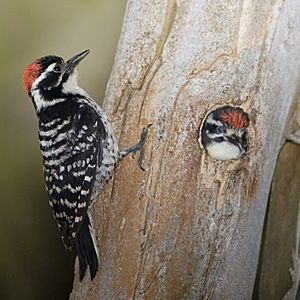Nuttall's woodpecker facts for kids
Quick facts for kids Nuttall's woodpecker |
|
|---|---|
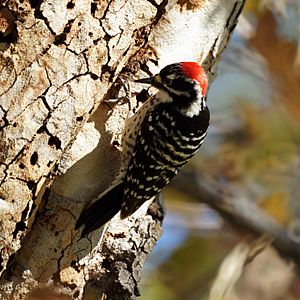 |
|
| Male in California, USA | |
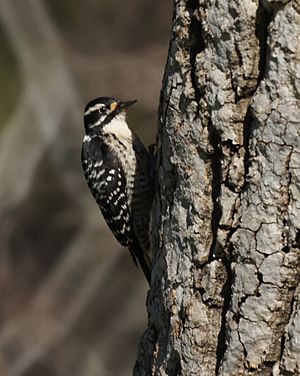 |
|
| Female in California | |
| Conservation status | |
| Scientific classification | |
| Genus: |
Dryobates
|
| Species: |
nuttallii
|
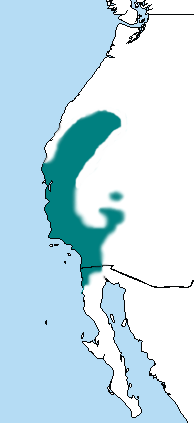 |
|
| Range of P. nuttallii | |
| Synonyms | |
|
Dendrocopos nuttallii |
|
The Nuttall's woodpecker (Dryobates nuttallii) is a type of woodpecker found in California. It was named after a scientist named Thomas Nuttall in 1843. These birds live in oak forests and look a lot like the ladder-backed woodpecker. They are also related to them.
Contents
What Nuttall's Woodpeckers Look Like
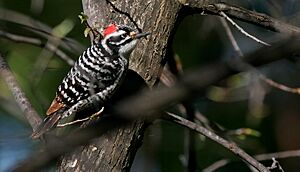
Nuttall's woodpeckers have black wings and tail feathers. These feathers have white stripes. Their belly is white with black spots and stripes. They have a black forehead with white stripes on the sides of their head. The top of their back is black without any stripes.
Adult male Nuttall's woodpeckers have a bright red cap on their head. Females do not have this red cap. However, young birds of both sexes have a red cap. Like other woodpeckers, they have special feet called zygodactyl feet. This means two toes point forward and two point backward. They also have stiff tail feathers. These features help them hold onto trees in an upright position.
Nuttall's woodpeckers weigh about 30 to 45 grams (1 to 1.6 ounces). They are about 16 to 18 centimeters (6.3 to 7.1 inches) long.
Where Nuttall's Woodpeckers Live
Nuttall's woodpeckers do not migrate, meaning they stay in the same area all year. They live mostly in northern California. Their home range extends south into the northwest part of Baja California, Mexico.
These woodpeckers prefer dry to moderately wet woodlands. They especially like oak forests. You can also find them in areas near rivers or in chaparral, which is a type of shrubland. This is especially true in the southern parts of their range where there are fewer oak trees. They live from sea level up to about 1,250 meters (4,100 feet) high. Sometimes, they can be found as high as 2,000 meters (6,600 feet). They have even been seen as far east as central Wyoming.
Nuttall's woodpeckers are not considered an endangered species. They are quite common in California. Scientists estimate there are over 100,000 of these birds in the world.
How Nuttall's Woodpeckers Behave
Woodpecker Sounds
Nuttall's woodpeckers make different sounds. These sounds are not musical. Here are some of their calls:
- Call note: This sound is used by a mated pair to tell each other where they are.
- Double call: This call is similar to the call note. It can also be used as a low warning sound if there is a threat.
- Rattle call: Woodpeckers use this sound to mark their territory when they are looking for food.
- Kweek call: This sound is used between male and female woodpeckers, mostly by the female before mating.
Both male and female Nuttall's woodpeckers also drum on trees. Their drumming sounds are usually long, lasting more than one second.
What Nuttall's Woodpeckers Eat
Nuttall's woodpeckers mainly eat insect larvae. These include larvae from wood borers, click beetles, and ants. They find these insects by tapping and poking into cracks in oak trees.
They also drink sap from holes made by other birds, like red-breasted sapsuckers. They get sap from birch and willow trees. Besides insects and sap, they also eat seeds from various berries.
Reproduction and Life Cycle
Nuttall's woodpeckers start to form pairs in late January to March. They usually lay their eggs in April and May. These woodpeckers are monogamous, meaning they have one partner. Both parents help take care of their young.
Each year, the male woodpecker digs a new nest hole. They make these nests in the hollows of dead trees, such as willow, oak, and alder. A female usually lays 3 to 6 eggs. The male sits on the eggs at night to keep them warm, and the female sits on them during the day. The eggs hatch after about 14 days.
The young birds, called fledglings, are ready to leave the nest about 29 days after they hatch. Their parents continue to care for them for about 14 days after they leave the nest.
See also
 In Spanish: Pico de Nutall para niños
In Spanish: Pico de Nutall para niños



